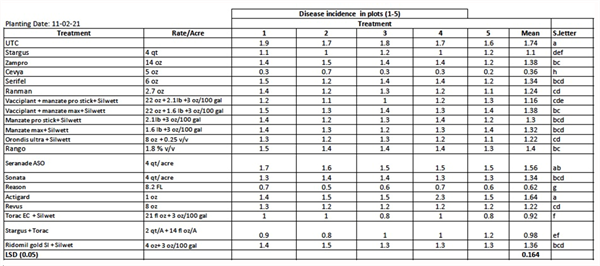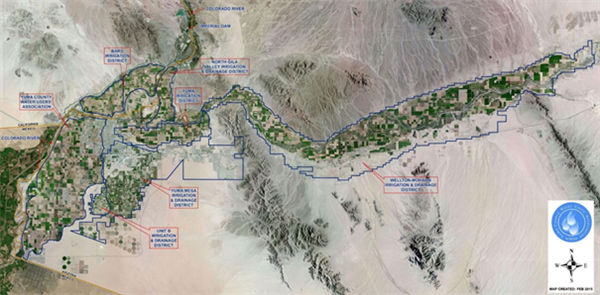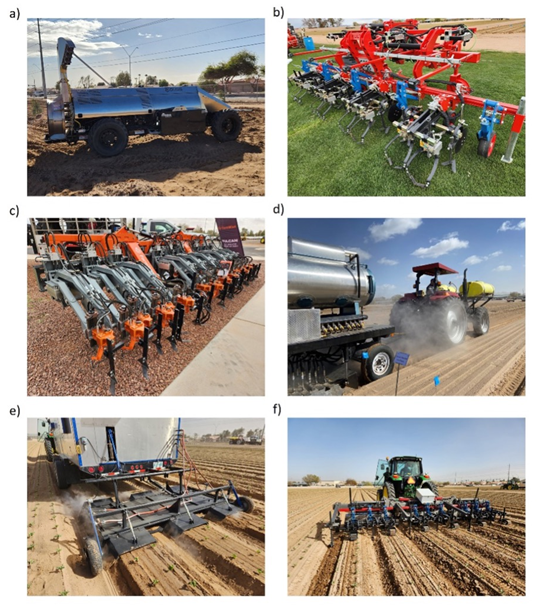Jul 12, 2023
2022-2023 Downy Mildew of Lettuce Fungicide Trial
Bindu Poudel-Ward, Martin Porchas Sr., Martin Porchas Jr., Neeraja Singh, Johan Murcia, and Rebecca Ramirez,and Jason Furr
Yuma Agricultural Center, University of Arizona, Yuma, AZ
This study was conducted at the Yuma Valley Agricultural Center. The soil was a silty clay loam (7-56-37 sand-silt-clay, pH 7.2, O.M. 0.7%). Lettuce was seeded, then sprinkler-irrigated to germinate seed on Nov 15, 2022 on double rows 12 in. apart on beds with 42 in. between bed centers. All other water was supplied by furrow irrigation or rainfall. Treatments were replicated five times in a randomized complete block design. Each replicate plot consisted of 25 ft of bed, which contained two 25 ft rows of lettuce. Plants were thinned Jan 5, 2023 at the 3-4 leaf stage to a 12-inch spacing. Treatment beds were separated by single nontreated beds. Treatments were applied with a tractor-mounted boom sprayer that delivered 50 gal/acre at 100 psi to flat-fan nozzles spaced 12 in apart.
|
Month
|
Max
|
Min
|
Avg
|
Rain
|
|
November (2022)
|
74°F
|
47°F
|
60°F
|
0.00
|
|
December (2022)
|
69°F
|
42°F
|
54°F
|
0.11
|
|
January
|
67°F
|
42°F
|
55°F
|
0.16
|
|
February
|
70°F
|
41°F
|
55°F
|
0.37
|
|
March
|
75°F
|
46°F
|
62°F
|
0.28
|
Downy mildew (caused by Bremia lactucae) rating was done on variety Magosa. Disease was first seen on 1-9-22. Foliar applications were made on January 13th, January 24th, and February 1st 2022. Disease rating was done on February 3, 2023. Fungicide application was done on : Feb-08, 2023, Feb 20, 2023 and March 2, 2023.
Disease rating was done March 15, 2023. Disease severity was determined by rating 10 plants within each of the five replicate plots per treatment using the following rating system: 0 = no downy mildew present; 0.5 = one to a few very small downy mildew colonies on bottom leaves; 1 = downy mildew present on bottom leaves of plant; 2 = downy mildew present on bottom leaves and lower wrapper leaves; 3 = downy mildew present on bottom leaves and all wrapper leaves; 4 = downy mildew present on bottom leaves, wrapper leaves, and cap leaf; 5 = downy mildew present on entire plant.
The data in the table illustrate the degree of disease control obtained by application of the various treatments in this trial. Most of the treatments exhibited activity against the disease to some extent. The most effective fungicides, that held the percentage of leaves that were infected to 20% or less, included Cevya, Reason, Torac EC and Stargus +Torac.

To contact Bindu Poudel go to:
bpoudel@email.arizona.edu










